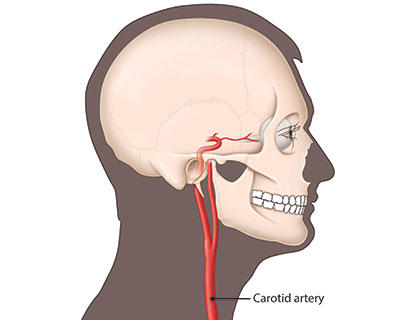What Is Carotid Artery Disease?
Carotid arteries are the main blood vessels in your neck that send blood to your eyes and brain.
There are two carotid arteries in your neck: one on the right side and one on the left side. Carotid artery disease is when blood flow through your carotid artery is blocked. Without enough oxygen from blood, your eyes and brain do not work properly. You may notice that one side of your body is weak or numb, and you may lose vision on this side of your body.

What causes carotid artery disease?
A buildup of material in your arteries causes a plaque to form. This buildup eventually narrows or hardens the arteries. Pieces of plaque can break off into the blood stream, slowing or blocking blood flow to the eyes and brain.
Vision problems may be warning signs of carotid artery disease
Know the warning signs of a possible blocked carotid artery. If you have these symptoms, call your primary care doctor or ophthalmologist right away.
- Vision that seems like a curtain is being drawn over your eye. This could be due to a temporary blockage in your carotid artery, called a TIA (transient ischemic attack, or “mini-stroke”). It may last a few minutes to an hour. This could be a warning sign that you may soon have a blocked carotid artery. Call your doctor right away.
- Loss of side vision or total vision loss. This, along with muscle weakness or paralysis on one side of your body, may be a stroke. This can happen when the carotid artery is completely blocked. Do not wait—get help right away if you think you are having a stroke.
Who is at risk for carotid artery disease?
People at increased risk for carotid artery disease are those who:
- smoke
- have high cholesterol
- drink a lot of alcohol
- are obese
- have high blood pressure
- are not physically active enough
- have a family history of carotid artery disease
Except for family history, you have some control over these risk factors. Talk with your doctor about ways to help reduce your risk of carotid artery disease. Your doctor may suggest that you eat a healthy diet, stay at a good weight, be active each day, and possibly take medicine.
How is carotid artery disease diagnosed?
Your ophthalmologist or primary care doctor may want you to have certain tests if you are at risk for carotid artery disease.
Tests may include certain types of scans of the body. Those scans can show how well blood is flowing through your carotid arteries. Your ophthalmologist might dilate (widen) your pupils and examine the back of your eye to check for blocked blood vessels.
Treatment of carotid artery disease
Your doctors will work as a team to treat carotid artery disease. Your treatment may include:
- blood-thinning medications (such as aspirin) to help prevent blood clots
- medicine to lower your blood pressure
- surgery to remove a blocked section of the carotid artery